I often write about using recipes as ideas. In fact, I find it almost impossible not to cook this way. Choosing a recipe, shopping for ingredients, and studying each step is time consuming. The results are often disappointing and the effort too high. Moreover, improvisation is essential for more nutritious cooking—whether its wholesome meals or healthy baking. When I take the same recipes and adapt them to my needs and tastes, I’m continually satisfied—both with the effort spent and the tasty results.
Sounds great, right? You may even cook dinner that way most nights. But do you bake this way too? My hunch is even those of us who are confident cooks are too insecure to make healthy baking substitutions. And sometimes you definitely shouldn’t—say with angel food cakes, croissants, and meringues. Technique is everything here. But muffins, pancakes, brownies and even some yeast breads? Not so much.
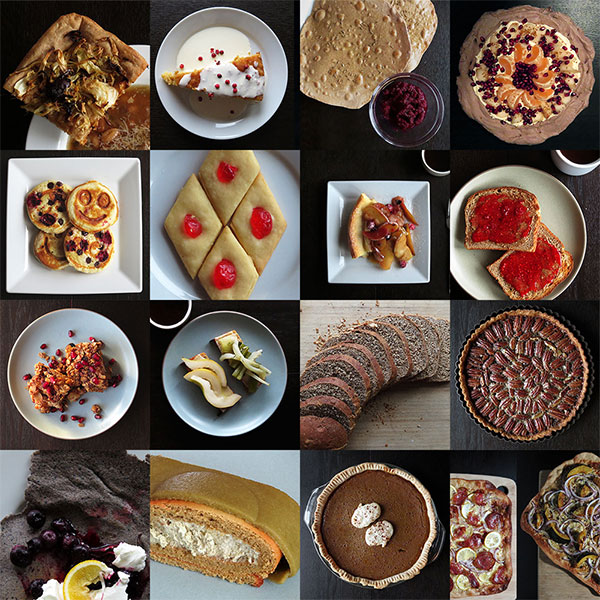
First I’ll give you tips for improvising, then follow up with recipes. But if you like examples more than rules, jump right ahead.
Choosing the Right Recipes
The key is to know which recipes are suitable for adaptation. I admit that experience gives you the best judgement. But even without it, these tips will help you pick good candidates for healthy baking substitutions:
Measure and Mix Recipes
The method will read something like: measure dry and wet ingredients, then stir and bake. This is basic—it’s not relying on special techniques. These are the best recipes to try adapting first.
Recipes using a Chemical Leavener
Typically these are recipe using baking powder and/or baking soda for leavening (not yeast or sourdough starter). This often means gluten development is not critical. Thus, a variety of flours will work. If a recipe does not use any of the above leaveners, I would resist making changes. It is relying on some special technique, such as whipped egg whites.
Certain Recipes for Yeast Doughs
With a more cautious approach, baked goods made with yeast are flexible as well. Choose recipes that approximate “measure and mix” (plus one or two rises). Pizza doughs and other flatbreads are good choices. The flours you use affect the final height during rising. But flatbreads don’t rely on height for success.
Healthy Baking Substitutions
There are many ways to make nutritious baked goods. For example, upping the amount of fruit or incorporating vegetables. But here I’m focused on four types of ingredients that are in every recipe: flour, sugar, fat and salt.
Replace the Flour*
A good rule of thumb for the cautious: Replace up to half of the white flour with whole wheat flour, or another flour with gluten, such as barley or spelt. For the uninhibited, replace it all. To use gluten-free grains, take a conservative approach. Substitute only a quarter of the wheat flour and increase the amount next time if successful. Pancakes and muffins are the most amenable to 100% gluten-free substitutions. For detailed information about baking with specific grains, see this handy guide.
Reduce the Sugar
While I use the term sugar here, I really mean any added sweetener. I find most recipes too sweet. This includes otherwise “healthy” recipes. I have never liked especially sweet foods. My first taste of bittersweet chocolate is when I understood the fuss. When I started baking, I usually made cake. One bite, and I complained that it was too sweet. It took me a while to figure out that you can put less sugar in recipes. Over the long term, if you keep reducing the sugar, you’ll start to prefer less and less of it. As a standard rule, I cut the sugar in half. If you eat a lot of processed foods, that’s likely not going to be sweet enough for you. But the concept still applies. Start by reducing the sugar a little, then next time a little more. (I learned to drink black coffee this way.)
Consider the Amount of Fat
In baking, the fat is usually butter. Sometimes it’s vegetable oil. Less often it’s some type of dairy, like cream cheese or sour cream. Coconut oil is now popular with vegans and the paleo crowd. In any case, I don’t usually change the amount, unless it’s excessive. How can you identify “excessive”? Whenever you find yourself thinking, “I’m supposed to use how much butter!” Sometimes, I reduce the amount by up to half. At other times, I replace half or more of the butter with applesauce. Applesauce—or other fruit sauces—will work best when there’s lots of other ingredients. Try applesauce in pancakes or brownies, but simply use less butter for scones or biscuits.
As a side note, there is another common fat used in baking: solid vegetable shortening (aka Crisco). And many people insist you need it for certain recipes. I know, I know. You can now buy shortening without trans fat. I don’t care. It’s still fake and I don’t use it. I find a new recipe. (Not much of a sacrifice. I’ve never seen a recipe using Crisco that looked all that special anyway.)
Do Not Cut the Salt
Yes, mom, I’m talking to you. For the average person wanting to reduce salt intake, don’t cut salt out of your cooking and baking. You’ll only succeed in making bland food you don’t want to eat. Instead, cut processed food out of your diet. Highly-processed foods contain more sodium than you will add when baking from scratch. So with salt, I say don’t worry about the amount and follow the recipe. A note about kosher salt—I use it for all my baking. But most recipes presume you’ll use table salt. Thus, I’m already reducing the sodium if I add the volume called for in the recipe.
Healthy Baking Examples
These examples are roughly organized from simple to more complex. Still, they’re all quite easy. I’ll start with pancakes. Feel free to skip to your interest: muffins, quick breads, tarts, scones, brownies, hamburger buns, or flatbreads.
The Most Simple Baked Goods
Pancakes
If you think you can’t bake, start with pancakes. It’s hard to make a bad pancake as long as you cook it long enough. I use moderate heat and let the pan get hot before adding the first batch. (I test the pan by flicking water at it. If it sizzles, it’s ready.) You can cook pancakes on almost any surface, but a pancake pan provides extra insurance. Even if the batter is too thick or thin, your pancakes will still turn out. You can also make more at once and small pancakes are easy to flip.
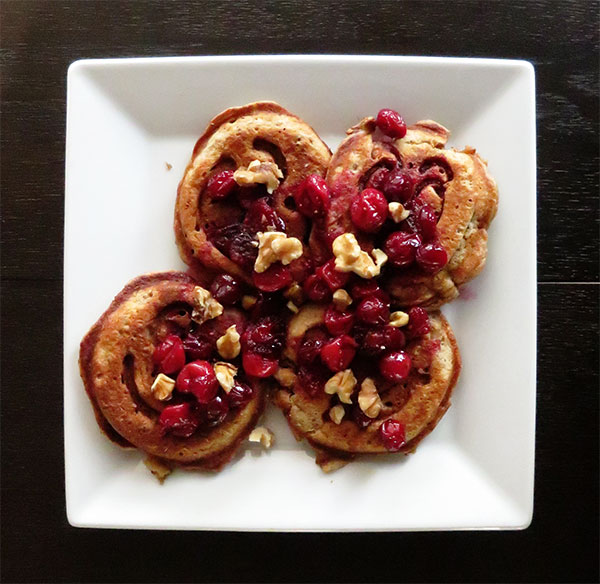
The original recipe uses refined flour. More disturbing though is the volume of cranberries is equal to the volume of maple syrup.
I replaced the white flour with Einka flour. This whole grain flour is a good substitute for white pastry flour as well. Try gluten-free flours in pancakes. They work because you don’t want gluten to develop anyway. (This is why you should be careful not to overmix the batter.)
If for no other reason than the cost, real maple syrup is far too expensive to use half a cup at breakfast. I doubled the fruit and only used a couple spoonfuls of syrup. My recommendation for pancake, waffle and crepe batters is to limit the added sugar. Instead, offer syrup at the table where you’ll notice how much you’re using.
Muffins and Quick Breads
How do you get a muffin with everything you love in it? You make it yourself, of course. Only harder than pancakes because you have to wait longer to eat them.
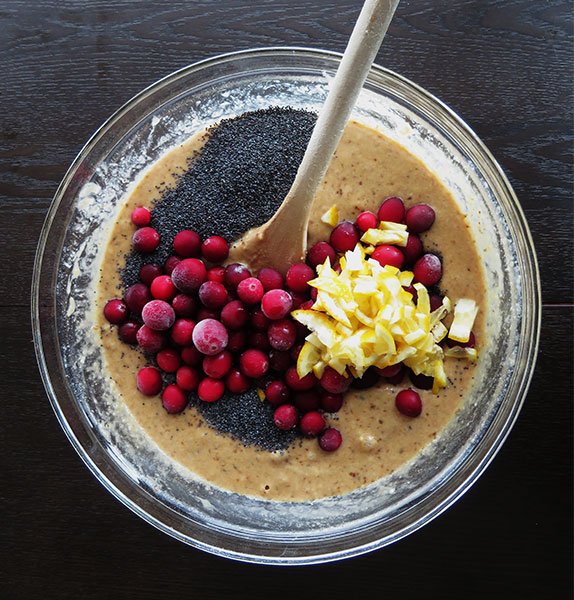
I used a muffin recipe that I return to again and again. The fresh fruit muffin, from the Macrina Bakery & Cafe Cookbook, can use whatever fruit is in season. I almost always add cranberries because their tart burst of flavor is so good with the sweet muffins. (I am partial to these berries—my grandmother makes a cranberry quick bread using the whole fruit. I always choose it over zucchini or banana bread.) The downside of this recipe is the all-purpose flour and 1.5 cups of sugar.
Like pancakes, muffins and quick breads are forgiving. They bake in molded pans, so don’t worry about the thickness of the batter. Still, I was more conservative with these muffins. I replaced the white flour with a third hard red wheat flour and a third almond flour. Almond flour is an (expensive) gluten-free flour that’s popular on the Paleo Diet. I use it once in a while because I like the taste. (It makes the best simple cakes, like this carrot almond cake or this summer special.) I cut the sugar in half, but kept the equal proportion of white and brown sugars. Because two types of sugar are one of the things that make this recipe unique.
The most fun thing about muffins and quick breads is you can stir in whatever you want. I finally tried my perfect combination: frozen cranberries, chopped Meyer lemon, poppy seeds, and cream cheese. I recalled buying muffins topped with cream cheese during college. I always wanted to recreate them. So brilliant. I’ll plop a spoonful on top of the batter before it goes into the oven.
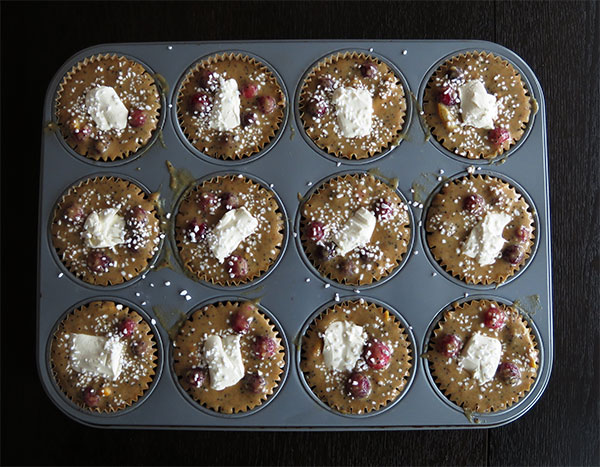
I baked the muffins at the last minute to take skiing. Distracted, I forgot to take a photo of the finished product. I also forgot about the cream cheese. (It sunk while the muffins were baking.) They still tasted delicious but now I call them cream cheese surprise muffins. You have no idea it’s in there until you taste them. (Even if you’re the baker.) In any case, they looked like this.
One final note about muffins and quick breads in case it’s unclear. There’s no difference between them. Bake quick breads in a bread pan instead of muffin tins. Thus, they take at least twice as long to bake.
Sweet Treats
I may as well call this section desserts. I mean does anyone expect these things to be healthy? So why even bother? That’s actually the perfect reason. Everyone gobbles these things up—even if you make them whole wheat, gluten-free, low sugar or vegan. (I’ve done rigorous testing and so far I’ve failed to get my Dad NOT to eat a batch of brownies I’ve made.) These foods fall into the second category of my list above about choosing the right recipes. They’re not quite as easy as “measure and mix” but still amenable to adaptation.
In fact, I baked these all on the same day. So how hard can they be?
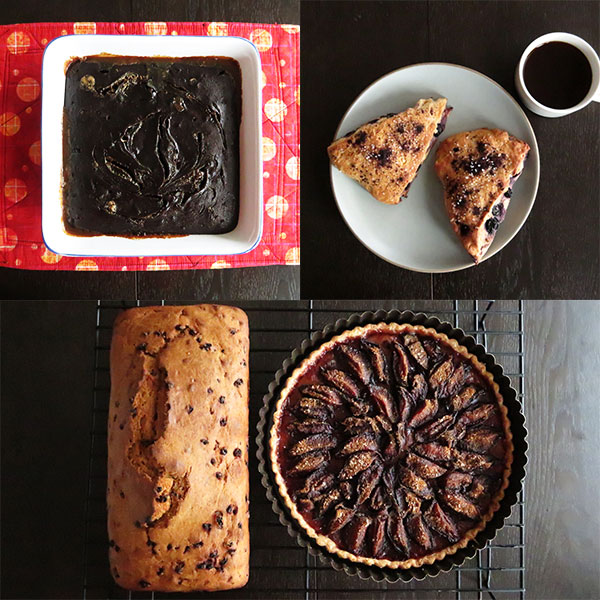
Tarts
Let’s start with the fruit tart. I misled you here. I’m not going to tell you much about it—I’m just showing off. But I will say, first, consider whether you actually need the amount of sugar called for in the recipe. And second, learn how to make a pie crust—a good one. (This means flaky and tender, and likely made with only butter or a mix of butter and cream cheese). I never ate pie until I started making it myself. I use a food processor for the crust, make more than one at a time, and freeze them. The sole reason I was able to add this tart to my to-do list was because I had both a pie crust and plums in the freezer. Pie crust requires some in-depth reading but after learning Rose Levy Beranbaum’s approach, I feel I’ve mastered it. For what’s it’s worth, I also rarely reduce the sugar in her recipes.
Scones
Now on to the “healthy” treats. I used this recipe as a template for the scones. Considering I altered almost every single ingredient, “template” is the right word here. Self-rising flour is all-purpose flour with baking powder and salt. I added those two ingredients and replaced the refined flour with hard white wheat flour. Note that “white” refers to the variety of wheat—the milled flour still contains the bran and germ. I cut both the sugar and butter. Adding more than one stick of butter always makes me pause. So I only used one stick and cut the sugar in half.
Besides the buttermilk, the other ingredients were dried blueberries and lemon zest. Now this is more about using what I had on hand rather than making it healthier. But the idea of a scone full of juicy blueberries was enticing. I patted out half the dough and completely covered it with frozen blueberries. Then, I patted out the other half and pressed it on top. I realized during this process that I may have gone overboard with the berries. But my extensive scone-making experience—scones are one of my mom’s favorites—gave me confidence. I managed to get them into the oven. I can now say this is the best scone recipe (with my adjustments!) and worth the trouble. Definitely not too many berries. In fact, the blueberries were the reason I could reduce the sugar with success.
The lemon was a minor change that made a huge flavor impact. A Meyer lemon is too valuable to me not to use the entire thing. So I do (well, except the seeds). Thin slices, chopped up and thrown into anything.
Soda bread is somewhere between a quick bread and a scone. Since I used a recipe from Whole Grain Baking, I only made one change to make it healthier. Instead of the 3/4 cup of sugar called for, I used 1/4 cup.
Brownies
Finally, what you’ve been waiting for: brownies. This is one of the easiest things to make healthier. Simply because they are so unhealthy to begin with. But also because they are rich and chocolatey, which disguises many of the things you put in them. Again I started with a recipe from Whole Grain Baking that used 100% whole wheat flour. I cut both the sugar and butter in half, replacing half the butter with applesauce from my freezer. I used cappuccino instead of chocolate chips, and swirled in caramel sauce before baking. (This addition invariably added some sugar back in). These last changes were about convenience rather than nutrition. I wanted to use up the ingredients.
Brownies are a tricky topic because everyone has a personal preference—fudgy, cakey, chewy, moist, dense, or fluffy. Some insist on a crackly top. I’m probably the wrong person to even comment on brownie recipes. I don’t care about any of those things. I never ate brownies until I started making them myself for two reasons. They are always too sweet. And the quality of the most important ingredient is generally an afterthought. So to my thinking, use a good quality cocoa, a judicious amount of sugar, and great brownies are inevitable. I use cocoa powder blends from King Arthur Flour and flavored cocoas from Intrigue Chocolate. The latter are actually cocoa mixes because they contain sugar—so I add even less sugar when I’m using them.
Hamburger Buns and Flatbreads
Finally, we get to the “hard stuff.” Baking with yeast. This is where I caution you to be, well, the most cautious. If your recipe depends on getting a good rise, be careful about swapping different flours. This means starting with pizza and other flatbreads, or even rolls or other small items. You’ll have a better chance of success than with a loaf of bread. But since breads have used whole grains longer than sweets, it’s easy to find a recipe for whole grain bread. (Longer refers to recent history here—at one point, everything was whole grain.) If you do alter bread recipes, you’ll want to have experience with breads first. I often find I need to add more flour than the recipe calls for. But there’s no way to know that except by observing the dough.
In any case, good-quality bread from a local bakery is easy to buy, even at the grocery store. But hamburger buns? Take a look at this:
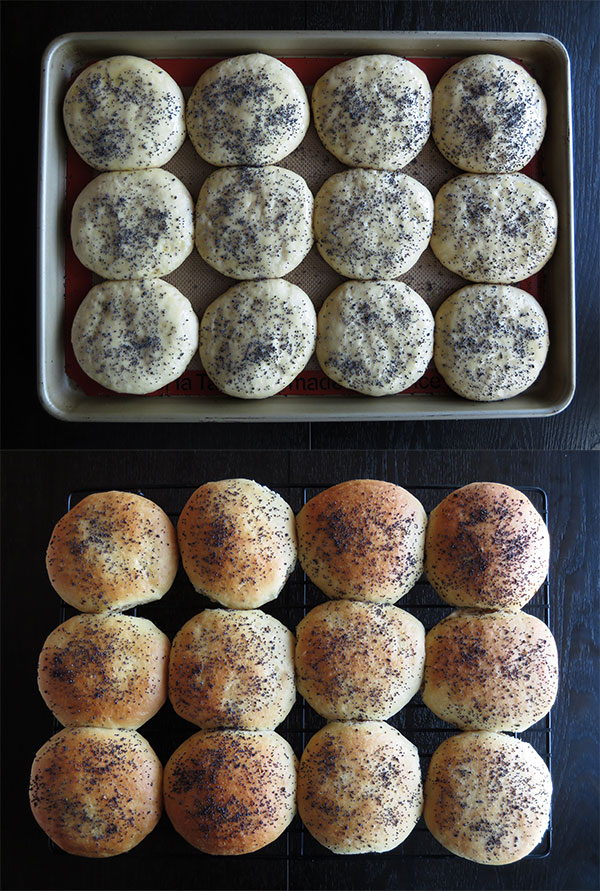
At this point, these changes may sound like my same old tricks: replace half the flour, cut the sugar in half. And they are! See how easy it is? I’ll add two comments though. First, the closest substitute for all-purpose flour is white whole wheat flour. If you’re used to the taste and texture of refined flour, I suggest starting with white wheat flour. If you like the results, move on to other whole wheat and whole grain flours. Second, having never made hamburger buns before, I was tentative. But the buns were fantastic with my healthy baking substitutions. So now I have the confidence to try upping the proportion of whole wheat flour next time. The key is to adapt recipes in stages so that you’re comfortable with each substitution.
Not that anyone needs ideas about what to do with hamburger buns … We made salmon burgers and they were excellent.
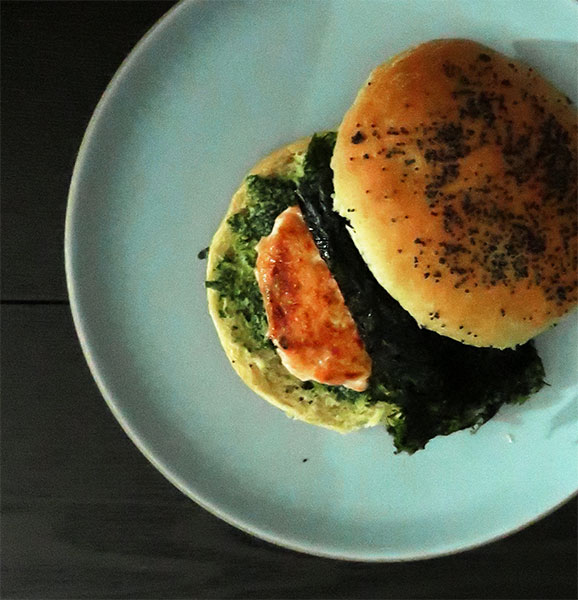
The pureed herbs were in the freezer. After thawing, I stirred the puree into horseradish and mayonnaise to approximate wasabi. Credit for the seaweed idea goes to my husband. I mentioned it was too bad we don’t have anything crunchy to put on the burgers. When Matt said seaweed, I thought yes, that’s a perfect fit. By the way, in case it’s not obvious, change the shape of the roll and you’ve got hot dog buns.
For other examples of baking with yeast, see my posts about 100% whole wheat pizza crust and foccacia bread.
Baking Mixes
Did I make this all sound so simple you can’t resist trying it? Or does healthy baking still sound like too much work? Okay, well here’s one more idea. Good-quality baking mixes. The “healthy” part is they only contain real ingredients. So these aren’t any old mixes. You can buy them from the same places I buy quality flours: King Arthur Flour, Bob’s Red Mill, and Bluebird Grain Farms. In truth, I don’t use mixes. But if you want to bake with them, these mixes will give you far better results. Try them instead of the inedible boxed stuff that has a dedicated aisle at most stores.
And now to contradict myself, I tried the sage biscuit mix from Bluebird Grain Farms and loved it. In fact, I had trouble limiting the number of biscuits I ate. They are a perfect accompaniment to a variety of meals (and really elevate leftovers).
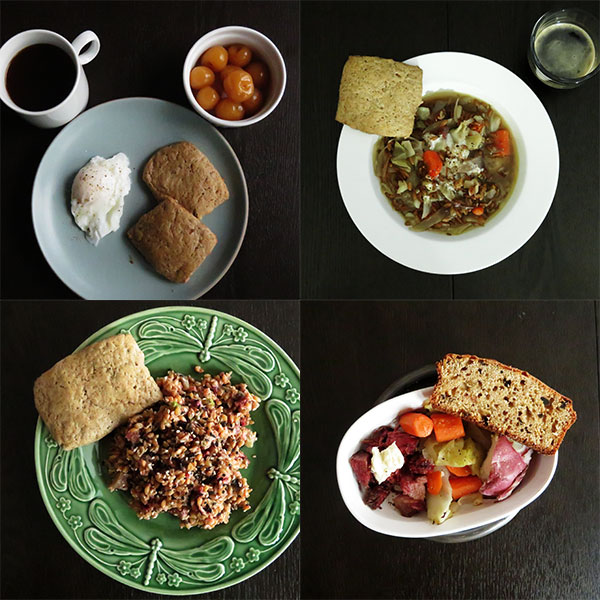
A Word About Confidence
This post is about healthy baking, but the advice applies to all your cooking. It’s hard to put in the effort with no guarantee of success. But unlike adhering to someone else’s recipe, you’ll learn from each attempt. It’s rare that something is so bad you have to throw it out. If you use quality ingredients and consider what you’re adding, it’s hard to go wrong. Look at how many people love muffins, donuts, and pancakes that aren’t even good! The biggest concern is undercooking. So the easy fix is to error on the side of overcooking. I’ve never bit into something I baked and thought oh no, I overbaked it. If the worst happens and you do underbake it? Slice and toast. Not perfect but still very good.
Healthy baking doesn’t mean you must abandon all your favorite recipes. It’s not about collecting a new set of whole-grain, gluten-free, low sugar, (insert health concern) cookbooks. These simple changes can make everyday recipes more nutritious. Be warned though. You’ll soon wonder how you ever ate those sugar-laden, smooshy muffins you used to love. And as far as buying baked goods? I’ll just say prepare to be disappointed.
One more thing—if you’re just getting started on the path to healthy baking (or any baking at all), watch my video for tips on choosing the right equipment. This starter set will enable you to make most of the baked goods I talked about in this post.
*Outside the scope of this post but worth mentioning. Baking is more accurate when measuring by weight versus volume. If you don’t have a scale, use volumes. But digital scales are inexpensive so consider buying one. You’ll find yourself using it for other cooking anyway. To be clear, say a recipe uses 4 cups of all-purpose flour. If you want to replace it with whole wheat flour, then you would use 4.25 cups. This is because 1 cup of white flour weighs 4 ounces, while the same volume of whole wheat flour weighs 4.25 ounces. So 4 cups of white flour x 4.25 ounces/cup = 17 ounces and 4.25 cups of whole wheat flour x 4 ounces/cup = 17 ounces. That is measuring and substituting by weight instead of volume.
AT KITCHENLISTER, OUR SECRET MISSION IS TO TURN EVERYONE INTO HOME BAKERS. WON’T YOU HELP US OUT? START A FREE ACCOUNT NOW.
Yes. I made all these things in March. Healthy baking is a doable and worthy goal. Whether you agree or not, leave me a comment.
All of the baked goods detailed in this post were part of my Week in Review meals for March 6–22, 2017.
